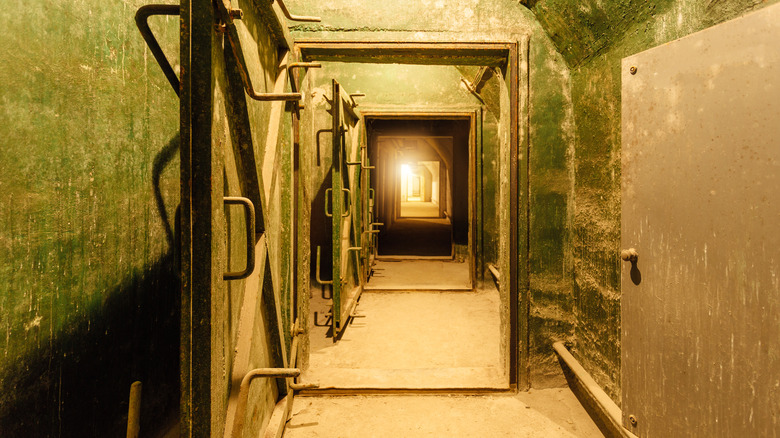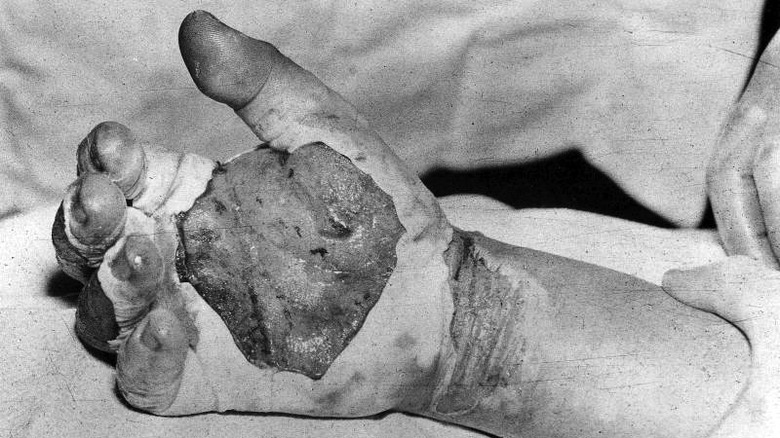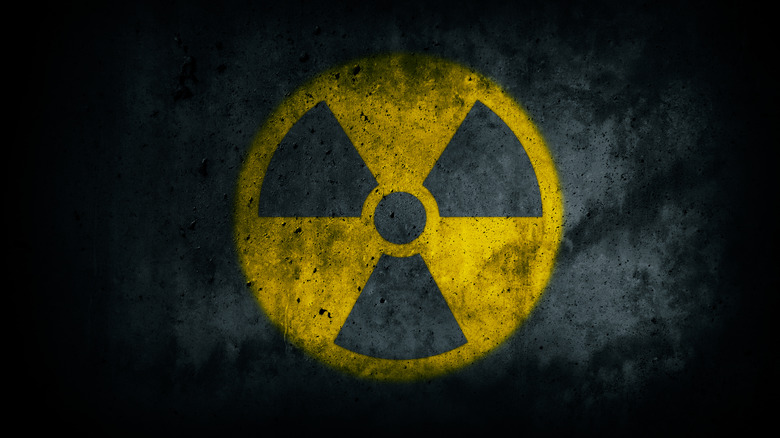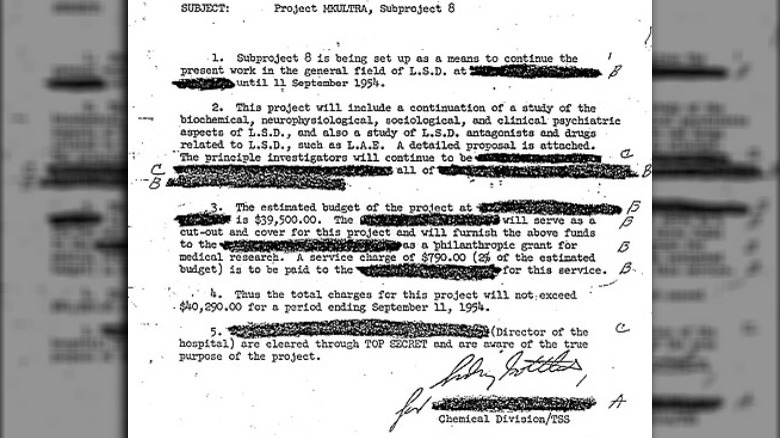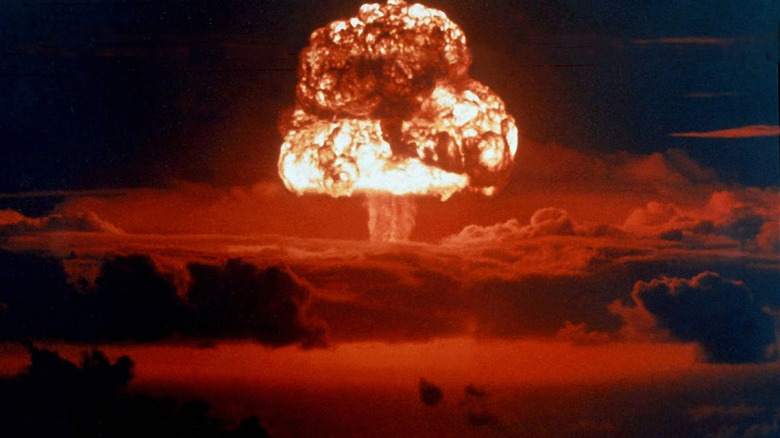Messed Up Things That Happened During The Cold War
When you hear "Cold War," what do you think of? Maybe it's the Space Race — Sputnik and the Moon landing and all of that. Maybe there's some thought of spies and espionage and sabotage. Or maybe it's just the looming threat of nuclear war and everything that would entail should the U.S. and the Soviet Union start firing nukes at each other.
And, yeah, all of those things were part of the Cold War, but there's a lot more than just that. For all the already scary aspects of the Cold War that are pretty well-known, there are plenty of lesser-known things done behind closed doors and kept locked inside once-secret files. In the end, the secrecy is almost understandable; there was some seriously messed up stuff going on during the Cold War.
With that in mind, here's a short list of just some of the weird things that happened. These events run the gamut of things you'd associate with the Cold War — radiation, espionage, nuclear weapons — but are all alike in being somehow concerning, terrifying, or morally reprehensible. In truth, "morally reprehensible" is a pretty common theme here.
The Demon Core was part of two deadly experiments
You probably know about the nuclear bombs that hit Japan in World War II, but did you know that a nuclear core developed for those bombs caused trouble even after the end of the war? As Science Alert explains, aside from the two nuclear cores in the bombs dropped on Hiroshima and Nagasaki, a third core was also prepared, but Japan surrendered before it could be used. Instead, that core was turned into a tool for Manhattan Project researchers interested in high-risk radiation experiments.
According to the American Physical Society, in August 1945, Harry Daghlian went into the lab alone and surrounded the core with tungsten carbide bricks, meant to reflect neutrons back to the core, pushing it closer to criticality. He accidentally dropped one of the bricks onto the core, which went critical, bathing Daghlian in the blue light of deadly reaction. That wasn't an isolated incident, though: Less than a year later, in May 1946, Louis Slotin was running a similar test, almost completely shielding the core with a pair of beryllium half-spheres, which he kept apart with just a screwdriver. That's just as dangerous as it sounds — the screwdriver slipped and, once again, the core went critical.
Both Daghlian and Slotin received deadly doses of radiation, and their deaths weren't pretty. Extreme blistering and burns, gangrene, entire patches of skin peeling off (like Daghlian's hand, above) — you get the picture. The core was fittingly dubbed the Demon Core, and afterward, criticality experiments were no longer conducted hands-on at Los Alamos.
Operation Delirium involved tests on soldiers
In the 1950s and 1960s, U.S. military doctor Jim Ketchum honestly believed that chemicals were the humane way to go (via NPR). No more bullets and guns — drugs like LSD and 3-quinuclidinyl benzilate (BZ, for short) could effectively take someone out of a fight, incapacitating them in exactly the way you might imagine. These were heavy drugs, after all.
But the military couldn't just start using these weapons. They had to test them out first, and their methods really played fast and loose with morality. Army personnel would consent to taking part in these experiments, but they were never told that they involved drugs. They might get sprayed in the face with a liquid they thought to be water but was actually LSD. Or they might get stuck in an experiment called "The Longest Weekend," described by We Are the Mighty as a three-day-long test in which four volunteers were dosed with varying levels of BZ and locked inside a room, where they had to complete "missions" (mostly relaying radioed information). One soldier was given a placebo, two were given a more moderate dose, and the fourth was high to the point of incapacitation, constantly confounded by being trapped.
And the reason for the secrecy? Researchers didn't want the volunteers' knowledge of being high to affect how they would act while drugged. It seemed best to have them go into things uninformed, though the whole idea of drugging unsuspecting volunteers is still pretty messed up.
Plutonium injections given to hospital patients
In the wake of World War II, radiation was a big topic, which makes a lot of sense given the fear of nuclear war. With that fear around, plus the knowledge that Manhattan Project researchers were actively handling radioactive elements, understanding the long-term effects of radiation exposure was pretty important (via the Atomic Heritage Foundation).
But that importance doesn't really justify the things that researchers did, namely testing the effects of radiation on unknowing subjects with injections of radioactive elements, even plutonium. Researchers would find hospital patients, ones with bleak diagnoses (which were sometimes later proven incorrect) and inject them with dangerously high amounts of plutonium. Those injections were kept completely separate from medical records and done without the patients knowing what the injections really were. In the end, it was all done to see how the body would hold onto or secrete the radioactive element.
The idea of plutonium injections is terrifying enough, and knowing they were done without consent is even worse. But it doesn't end there. The doses given to these patients were sometimes five times the maximum limit that the body might be able to handle and were given while knowing that plutonium would be absorbed by bones and kept there for years. (It was found that about 90% of the plutonium was absorbed into the bones.) So not only did researchers know that these injections wouldn't be helpful, but they also had a pretty good idea that they would actually be harmful.
The Vanderbilt 'nutrition study' dosed pregnant women with radiation
With thoughts of nuclear war on everyone's mind, a number of different studies were undertaken during the Cold War that involved radiation. The problem was that ethics were often a secondary concern.
The Associated Press reports that, in the 1940s, researchers at a free clinic at Vanderbilt University gave over 750 pregnant women iron pills, stating in 1951 that the idea was to study how iron was absorbed by pregnant women. The Alliance for Human Research Protection has similar information but states that 820 pregnant women were given iron in some "cocktail" which they drank.
Either way, that doesn't sound too terrible in and of itself. The problem? Those pills or cocktails contained radioactive iron (apparently intended as a tracer for absorption mechanisms). Plus, there's a pretty decent chance that none of those women actually knew what was in those pills or drinks or that they were part of an experiment without their consent. Oh, and the records were destroyed in the 1970s. Not suspicious at all.
So, what happened? Studies in the 1960s indicated that a handful of those women's babies died really young as a result of various cancers. Initially, those results were written off as insignificant, but later investigations concluded that, no, it was probably because of exposure to radiation. After all, when comparing to a group of unexposed women, there weren't any similar cases. This isn't a statistical analysis you're reading here, but that does sound significant.
Project MK-Ultra broke brains
In the 1950s and '60s, the CIA was legitimately concerned about mind control and decided to become masters of it themselves. (Yes, this is real; History talks about it.) NPR's interview with journalist Stephen Kinzer explains that the point of this operation — called MK-Ultra — was to find a way to essentially break the human psyche and then replace that person's consciousness with whatever the CIA wanted. The second part of that didn't get off the ground, but the first definitely did.
MK-Ultra's experiments came in a number of different forms and were conducted in a bunch of different places. The techniques would include electroshock treatments, extreme temperatures, isolation, general psychological torture, and drugs. Lots of drugs. (The head of the project, Dr. Sidney Gottlieb, actually wanted to buy the entire world's stock of LSD.) Some people volunteered, including students, but others definitely didn't, like prisoners whom the researchers figured were expendable. In general, most people didn't really know what they were signing up for.
Mob boss Whitey Bulger, who was incarcerated at the time, described his experience, saying he thought he was part of a study to cure schizophrenia. What really happened was that he was dosed with LSD every day for over a year (via NPR). The descriptions of his hallucinations are terrifying: people turning into skeletons, blood dripping from the walls, and more (via History).
Oh, and to top it all off, the project hired Nazi doctors for their expertise, and then most of the records were destroyed. Need more be said?
Operation Midnight Climax was a mishmash of voyeurism and LSD
In San Francisco in 1955, there was a nice, unassuming house, furnished with a French theme. It was actually a CIA safe house, made up to have a "French whorehouse look" (via Medium).
225 Chestnut Street was the main location for Operation Midnight Climax, one of the more bizarre experiments of Project MK-Ultra (via History). Basically, the CIA had hoped to use LSD as some sort of truth serum, and combine that with their findings that subjects were more likely to give up secrets shortly after sex, and, well, you have Operation Midnight Climax. CIA agents paid female sex workers to lure unwitting subjects (usually poor and working-class, thus less likely to cause legal problems) back to the safe house, where they would be dosed with LSD. From behind a two-way mirror, the CIA could just watch what happened next, supposedly learning how to weaponize both drugs and sex.
It's weird, and it didn't stop there. A second safe house was set up in Marin County, and it became the CIA's playground for all sorts of different substances and delivery methods — especially the most dangerous ones. To top off this nightmare cake, George White, the head of the operation, just loved the voyeuristic aspect of it all, later calling it "fun, fun, fun" and asking, "Where else could a red-blooded American boy lie, kill, cheat, steal, rape, and pillage with the sanction and blessing of the All-Highest?"
Lab X: the KGB's poison factory
During the Cold War, the Soviets got really creative with poison, and incredibly invested, too. According to Atlas Obscura, they'd created an entire facility dedicated to perfecting poisons back in 1921. This facility — called the Special Room, Laboratory No. 1, Lab X, Laboratory No. 12, and the Kamera (or "the Chamber") at different points — had a particular goal in mind: discovering poisons that were odorless, tasteless, and invisible to autopsies.
In chasing that goal, the lab did come up with some pretty scary stuff. The Wall Street Journal mentions deadly gases, like a gaseous form of cyanide, as well as poisons that made the cause of death appear to be a heart attack. Then there were other techniques and weapons, like a poison-tipped umbrella or the idea to spray the poison on a lamp so that the heat would disperse it throughout a room.
As The Guardian explains, a bunch of people fell to these poisons, including potential spies, dissidents, and political enemies. And that's not counting the unfortunate test subjects — usually political prisoners, in this case. Of course, everything was covered up and kept secret. In fact, the whole operation was so secretive that even Mikhail Gorbachev was denied a briefing in 1988, and as of 2018, there was speculation that the program was still going, functioning the same way it did decades ago.
Project A119: a nuclear publicity stunt
The U.S. wanted to nuke the Moon. That might sound like the plot of a bad sci-fi movie, but sometimes, truth really is stranger than fiction.
History explains that Sputnik was the immediate cause behind this absolutely ridiculous-sounding plan. When the satellite was successfully launched in 1957, it suddenly looked like the Soviets had taken the lead in the Space Race. To U.S. officials, that was disastrous. They needed something big and flashy, something utterly ridiculous just to prove to the rest of the world that the U.S. was still the bigger military power (via ABC). And that brought along the question: Is it possible to launch an H-bomb at the Moon? And would that create a mushroom cloud visible to everyone on Earth?
Research into this really was conducted, leading to the answer that it was entirely possible to hit the Moon with a hydrogen bomb. Obviously, the U.S. didn't actually go through with it. It was concluded that because the Moon doesn't have an atmosphere like Earth's, there wouldn't really be a big mushroom cloud: Debris would fly up but not back down, so no distinct mushroom shape. On top of that, people on Earth would probably just see the flash of an explosion — way less exciting than intended. Also, poor publicity stunt prospects aside, people weren't exactly on board with bombing a place that humans might want to (and eventually would) visit in the future.
Project Pluto would have rained radiation on everything
Given the paranoia and constant fear over nuclear warfare that was ever-present during the Cold War, is it really all that surprising that this era saw the development of some absolutely insane weapon ideas?
Project Pluto was one of those. Basically, the plans detailed a new kind of nuclear missile, one which Scientific American explains would have been powered by a nuclear reactor. It would take in air, heat it up, and use that expanded air to propel itself. The so-called SLAM missile could fly for long stretches of time, all while being easily maneuverable, before reaching its target and detonating the warhead it carried.
But the cruise missile was also uniquely devastating. The nuclear reactor that it used to propel itself wasn't actually shielded by anything; concrete would've made it too heavy to fly. What that meant was that all the radiation the reactor created would just be released into the air, raining down on whatever the missile flew over. That wasn't all, though. The supersonic missile was also loud — so loud that the designers thought that anyone it passed over would be killed by the shock wave alone.
Basically, this thing would have been a flying death machine, spewing radiation and shattering windows everywhere it passed. Aside from the horrifying image the missile presented, it was impossible to test, couldn't be flown over friendly territory at all, and was ultimately abandoned in 1964.
The U.S. conducted clandestine bacterial tests
If you've heard of the Geneva Conventions, maybe you've also heard of biological warfare being outlawed in the 1920s (via HistoryNet). But that didn't end research into it. Anthrax, cholera, and botulinum toxin could easily be devastating, so during World War II, the U.S. sponsored research into these weapons.
More questionable, though, were the tests on civilian populations through the 1950s and '60s. Agents would carry briefcases or lightbulbs into airports or subways, releasing bacterial agents into the air to track how bacteria might travel through a population. The Pentagon itself was even a test location.
A really big test, though, was done in San Francisco in 1950. Two types of bacteria were sprayed into the air of San Francisco Bay over the course of about a week, as Donald Jeffries writes in "Crimes and Cover-ups in American Politics." The city's inhabitants were breathing in millions of these bacteria every day, and at least one person died, potentially from the tests. (The researchers believed the bacteria they used to be harmless, but later reports say "harmless" is a bit of an understatement.)
Well over 200 of these tests were conducted, and the civilian populations affected had no say in what was happening, nor any idea they were being used as guinea pigs. And even when the government was confronted with the San Francisco experiment, they managed to shirk responsibility for any damage and even claimed they didn't need the public's permission to carry out these tests.
A plan to sacrifice two million people
A lot of the Cold War is characterized by the fear of nuclear war — tension about what might finally set off worldwide conflict between NATO-aligned countries and those behind the Iron Curtain, bound by the Warsaw Pact. Fortunately, that war never happened, but it could have.
According to The Washington Times, the Polish government released secret military documents, including a map of Europe detailing a speculative war game. A bunch of cities — particularly in Germany — were blotted out, intended to be destroyed by Soviet missiles, while cities like Prague and Warsaw were expected to be leveled by NATO strikes.
The whole thing was presented as a counterstrike against a NATO-instigated assault, but DW mentions a scary point about the whole deal: The Polish government was willing to accept the destruction of 43 Polish cities and the death of over 2 million Polish citizens, none of whom had any idea their lives were being played with. Had this situation actually happened, none of those people would've had a say in being, essentially, sacrificed by their own government.
To top it all off, analysis of those plans has led to the conclusion that the nuclear attacks likely weren't a Soviet counterstrike but the beginning of a speedy invasion of Western Europe. The lie about it being a counterstrike was an illusion of righteous defense, one that would've led to millions of deaths. It's just a good thing this plan never went through.
